Type V ship
The Type V ship is a United States Maritime Commission (MARCOM) designation for World War II tugboats. Type V was used in World War II, Korean War and the Vietnam War. Type V ships were used to move ships and barges. Type V tugboats were made of either steel or wood hulls. There were four types of tugboats ordered for World War II. The largest type V design was the sea worthy 186-foot (57 m) long steel hull, V4-M-A1. The V4-M-A1 design was used by a number of manufacturers; a total of 49 were built. A smaller steel hull tugboat was the 94-foot (29 m) V2-ME-A1; 26 were built. The largest wooden hull was the 148-foot (45 m) V3-S-AH2, which 14 where built. The smaller wooden hull was the 58-foot (18 m) V2-M-AL1, which 35 were built. Most V2-M-AL1 tugboats were sent to England for the war efforts under the lend-lease act. The Type V tugs served across the globe during Work War II including: Pacific War, European theatre and in the United State. SS Farallon and other Type V tugs were used to help built Normandy ports, including Mulberry harbour, on D-Day, June 6, 1944 and made nine round trips to Normandy to deliver Phoenix breakwaters.[1][2]
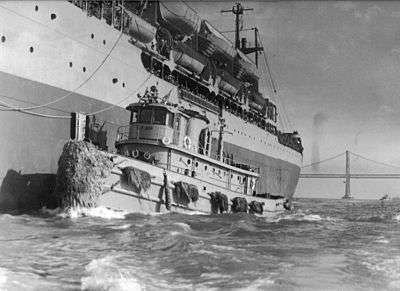
Tugboats are used to maneuver vessels and barges by pushing or towing them. Tugs are needed to move vessels that either should not move by themselves, such as large ships in a crowded harbor or a narrow canal, or those that can not move by themselves, like as barges, disabled ships, or log rafts. [3] Tugboats are powerful for their small size and are strongly built. Early tugboats used steam engines, but most have diesel engines now. Many tugboats have firefighting water cannons, allowing them to assist in firefighting, especially in harbors. Some minesweepers like USS Vireo, USS Lark and USS Kingfisher were converted to ocean tugs for the war.
Ships in class
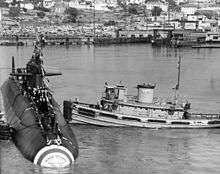
V2-ME-A1
Named for small US ports. Steel hull, 325 tons, 100 feet long, beam 25 feet, draft 11.5 feet. Engines 805 or 1,060 horsepower. Use as Army Transport Service or US Navy tugs, with designations of YT, YTB, or YTM (Yard Tug Medium). Built by" Birchfield Shipbuilding & Boiler Co, Ind de Tacoma in Washington 6 tugs; Canulette Shipbuilding Co. de in Slidell, La. 4 tugs; Calumet Shipyard & Drydock Co. de in Chicago, Ill. 5 tugs; Ira. S. Bushey & Sons de in Brooklyn. NY. 5 tugs; General Ship & Engine Works in East Boston, Mass. 2 tugs; and Brunswick Marine Construction Corp in Brunswick. Ga. 4 tugs.[4]
- Port Angeles sold to US Navy 1942 renamed USS Hiawatha (YT-265), scrapped
- Port Blakely sold to US Navy 1942 renamed USS Pocahontas (YT-266) sold private 1972, scrapped
- Port Discovery Sold to US Navy 1942 renamed Pogatacut (YT 267), sold private 1970, scrapped[5]
- Port Ludlow Sold to US Navy 1942 renamed Red Cloud (YT 268), sold private 1972, scrapped[6]
- Port Madison Sold to US Navy 1942 renamed Sakarissa (YT 269), to MARAD 1974, now at Amphibious Forces Memorial Museum[7][8]
- Port Orchard To US Navy 1942 renamed Santanta (YT 270), sold private 1972, now Maris Pearl[9][10]
- Port Allen To US Navy 1942 renamed YTB 723, to MARCOM 1945, sold 1975, scrapped[11]
- Port Barre Sold private 1946 renamed Standard No 2, scrapped
- Port Hudson Sold private 1946 Wabaquasset (YTB-724), then Crescent Towing[12]
- Port Vincent Sold private 1946 Standard No 3, scrapped
- Port Byron To US Army 1942 renamed LT 113, sold 1946 renamed Dalzellaird, scrapped 197x[13]
- Port Allegheny To US Army 1942 renamed LT 114, sold 1946 renamed Dyer, later Porpoise, Sachem, now *Porpoise
- Port Elizabeth To US Navy 1943 renamed USS Namequa (YT-331), sold private 1950, scrapped
- Port Conway To US Navy 1943 renamed Nesutan (YT 338), sold private 1950, scrapped[14]
- Port Fulton To US Army 1943 renamed LT 238, sold private 1946, scrapped
- Port Chester To US Army 1943 renamed LT 233, sold 1946, scrapped
- Port Crane To US Navy 1942 renamed Swatane (YT 344), sold 1964, scrapped[15]
- Port Henry Sold 1945, renamed Captain Rodger, wrecked 1947
- Port Jervis Later Newport, Felicia, Terror, R. H. Tripp sank 2005 hurricane
- Port Kent To US Navy 1942 renamed Oratamin (YT 347), sold 1969, scrapped[16][17]
- Port Clyde To US Army 1942 renamed LTC William R. Kendricks, sold renamed Resolute, scrapped
- Port Huron To US Army 1942 renamed LTC Herbert L. Kidwell, sold renamed: Port Huron, Dalzelloch, Dalzellido and Joan McAllister, scrapped.[18]
- Port Wentworth To US Navy 1942 renamed Haiglar (YT 327), sold private 1947 Limon, Frank W.Barnes, Sandra, Sandra St.Philip, Tanda 12, Tug McGraw, scrapped[19]
- Port Clinton Sold private 1945 Captain, Fred B.Dalzel, New Castle, Eliot Winslow, scrapped
- Port Deposit To US Navy 1942 renamed Mauvilla (YT 328), sold private 1963, scrapped[20]
- Port Edwards Sold private 1945 Hercules, Bear", scrapped
V4-M-A1
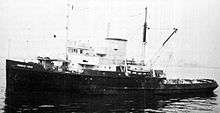
The V4-M-A1 was the largest and most powerful tugs in the world when they were built. Each was named after lighthouses, built in 1943. Steel hull, 1,613 tons, 195 foot long, beam 37.5 foot, draft 15.5 foot. Max. speed 14 knots. There were two engine manufacturers: National Supply Company, with 8-cylinder sets of 3,200 bhp and the Enterprise Engine & Trading Company with 6 cylinders and 2,340 bhp power. The V4s operated by Moran Towing & Transportation in New York on behalf of the War Shipping Administration. Built by: Avondale Marine in Westego, LA, General Ships & Engine in East Boston, MA, Pennsylvania Shipbuilding in Beaumont, TX, Globe Shipbuilding in Superior, WI, Froemming Brothers in Milwaukee, WI, Pendleton Shipbuilding in New Orleans, LA.[21][22][23][24]
- Seguin Scrapped 1976
- Sand Key Scrapped 1977
- Sanibel Island Scrapped 1972
- Sabine Pass Helped with Normandy landings, Scrapped 1978
- Point Loma Scrapped 1972
- Anacapa Scrapped 1973
- Point Vicente To Mexico 1969 renamed Huitilopochtli (A 51)
- Point Arguello Scrapped 1973
- Matagorda Sank 1946
- Aransas Pass Scrapped 1973
- Sombrero Key To Argentina 1965 renamed Thompson, scrapped
- Dry Tortugas To Argentina 1965 renamed Goyena, scrapped
- Southwest Pass Scrapped 1973
- Montauk Point To Mexico 1969 renamed Quetzalcoatl (A 12)
- Moose Peak Helped with Normandy landings, To Mexico 1969, sank 1974[25]
- Boon Island Sank 1976
- Gay Head Helped with Normandy landings, Scrapped 1977
- Bodie Island Helped with Normandy landings, Scrapped 1973
- Great Isaac Helped with Normandy landings, Sank 1947 collision with Norwegian freighter Bandeirante
- Tybee Scrapped 1978
- Point Sur Scrapped 1974
- Farallon Use to built Normandy port on D-Day, June 6, 1944, made 9 round trips to Normandy, To Mexico 1969, scrapped 1978
- Point Cabrillo Scrapped 1974
- Trinidad Head Helped with Normandy landings, Scrapped 1969
- Scotch Cap Scrapped
- Watch Hill Scrapped 1973
- Wood Island Scrapped 1973
- Sands Point Scrapped 1982
- Point Judith Scrapped 1978
- Black Rock Helped with Normandy landings, Scrapped 1969
- Sankaty Head Helped with Normandy landings, Scrapped 1978
- Yaqina Head Sold private 1971, scrapped
- Bald Island Scrapped 1973
- Fire Island Scrapped 1972
- Libby Island Sold private 1971, scrapped
- St. Simon Scrapped 1977
- Petit Manan Scrapped 1976
- Burnt Island To Mexico 1969, scrapped 1979
- Stratford Point Scrapped 1978
- Two Harbors Scrapped 1972
- White Shoal Sold private 1975, scrapped
- Cubits Gap Scrapped 1976
- Hillsboro Inlet Helped with Normandy landings, Scrapped 1977
- Jupiter Inlet Sold private 1971, scrapped
- Pigeon Point To Mexico 1969, scrapped 1970
- Point Arena Scrapped 1976
- Bayou St. John Scrapped 1977
- Mobile Point Sank 1944
- Race Point Scrapped 1972
V3-S-AH2

Some classed as YTB-Yard Tug Big. A Douglas fir wood hull ship, 1,220 tons. Engine was a reciprocal steam triple expansion. Max of 1,000 hp. Max of 10 knots without tow. About 6 knots with a tow. Range of 1,500 miles. Manned by a crew of 27.Built by Corpus Christi SB, Puget Sound SB Company, Standard SB Company of San Pedro, California, and Astoria SB Santa Barbara. Dimensions: Length 157 feet long, beam 32 feet, depth 18 feet, draft 15 feet.[26]
- Sustainer To USSR
- Compeller To Britain renamed Atherida, sold private 1948, scrapped
- Dexterous To Britain renamed Athelney, to Trinidad 1945, to Caymans 1948, scrapped 1951
- Mighty To Britain renamed Atil, sold private 1948, scrapped
- Secure To Britain renamed Attigny, sold private 1948, scrapped 1955
- Forthright To Britain renamed Attock, to USN renamed YTB 610, to USSR 1944 renamed Forthright
- Power To Britain renamed Atengo, to Italy 1947 renamed Titano, scrapped 1974
- Steadfast To Britain renamed Atako, wrecked and lost 1944
- Durable To Britain renamed Ataran, to Italy 1947 renamed Ciclope, scrapped
- Spirited To Britain renamed Atolia, to Trinidad 1948, to Caymans 1951, scrapped
- Helper To Britain renamed Atoyac, to Italy 1949 renamed Nereo
- resister To Britain renamed Atiamuri, sold to Italy 1947, sold to Israel 1954
- Superb To Britain renamed Atwood, sold to Trinidad 1948, sold to Caymans 1951, scrapped
- Robust To Britain renamed Atmore, sold private 1948, scrapped
V2-M-AL1
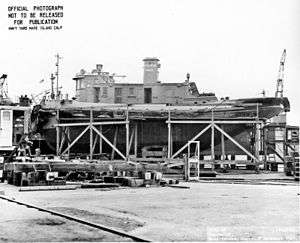
Port Sewall class tug. Named for American ports. All but one tug went for Lend-Lease use, some serviced in the Mediterranean Sea in WW2. V2-M-AL1 were: Wood hull, 90 tons, beam 19 foot, diesel engine with 240 horsepower, fuel Oil: 1920 gallons. Built by Puget Sound SB, Standard SB, Steinbach IW, Eureka SB, Arlington SB, Texas SB, Siletz BW, Blair Company, Marinette Marine and Texas SB.[27][28]
- Port Sewall To Britain as a "TUSA" = Tug, USA. (YN 1563)
- Port Kennedy To Britain as a "TUSA" YN 1564
- Port Reading To Britain as a "TUSA" YN 1565
- Port Costa To Britain as a "TUSA" YN 1
- Port San Luis To Britain as a "TUSA" YN 2
- Port Chicago To Britain as a "TUSA" YN 3
- Port Gamble To Britain as a "TUSA" YN 4
- Port Tobacco To Britain as a "TUSA" YN 5
- Port Haywood To US Navy renamed YTL 718, sold private 1947 renamed Limpiar.(YTL= Yard tug, little)[29]
- Port Inglis To Britain as a "TUSA"
- Port Mayaca To Britain as a "TUSA"
- Port Orange To Britain as a "TUSA"
- Port Richey To Britain as a "TUSA"
- Port St. Joe To Britain as a "TUSA"
- Port Tampa City To Britain as a "TUSA"
- Port Arthur To Britain as a "TUSA"
- Port Bolivar To Britain as a "TUSA"
- Port Lavaca To Britain as a "TUSA"
- Port Neches To Britain as a "TUSA"
- Port O'Connor To Britain as a "TUSA"
- Port Sullivan To Britain as a "TUSA"
- Port Stanley To Britain as a "TUSA"
- Port Townsend To Britain as a "TUSA"
- Port Ewen To Britain as a "TUSA"
- Port Gibson To Britain as a "TUSA"
- Port Jefferson To Britain as a "TUSA"
- Port Leyden To Britain as a "TUSA"
- Port Austin To Britain as a "TUSA"
- Port Homer To Britain as a "TUSA"
- Port Hope To Britain as a "TUSA"
- Port Sanilac To Britain as a "TUSA"
- Port William To Britain as a "TUSA"
- Port Wing To Britain as a "TUSA"
- Port Sulphur To Britain as a "TUSA"
- Port Treverton To Britain as a "TUSA"
ATR-1 class rescue tug
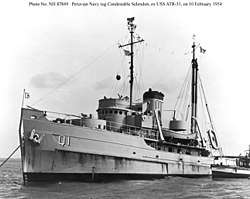
ATR-1-class - Auxiliary Tug Rescue was a wooden hulled rescue tug were built by Wheeler SB, Northwest Shipbuilding, Frank L. Sample, Jakobson SY, Camden SB, Lynch SB, and Fulton Shipyard in 1944 and 1945. The 89 ATR-1 tugs serviced WW2 in both Asiatic-Pacific Theater and the European theatre of World War II. The 40 ATR-1 Class had a displacement of 852 ton lite and 1,315 ton fully loaded. They had a Length of 165' 6", a Beam of 33' 4" and Draft of 15' 6". Top speed of 12.2 knots. The largest boom had a capacity of 4 tons. They were armed with one 3"/50 dual purpose gun mount and two single 20mm AA gun mounts. The crew complement was five Officers and 47 Enlisted men. They had a fuel capacity of 1,620 Bbls. The propulsion was one Fulton Iron Works vertical triple-expansion reciprocating steam engine with two Babcock and Wilcox "D"-type boilers with a single propeller of 1,600shp. They had two turbo drive Ships Service Generators, rated at 60 kW 120 V D.C. Example is USS ATR-31 [30][31][32][33]
Cherokee-class tugboat
.jpg)
The Cherokee class of fleet tugboats, originally known as the Navajo class, were built for the US Navy for World War II with a displacement of 1,235 long tons (1,255 t). Had a length of 205 ft (62 m), a beam of 38 ft 6 in (11.73 m), a draft of 18 ft (5.5 m). Has propulsion of a diesel-electric engine with 1 shaft at 3,600 hp (2,685 kW) and a top speed of 16.5 knots. Class AT for Auxiliary Tug, example: USS Navajo (AT-64).
Abnaki-class tugboat
_and_Soviet_trawler_Gidrofon_underway_in_the_South_China_Sea_on_18_December_1967_(K-43379).jpg)
Abnaki-class tugboat were Ocean fleet tugboats that were built for the US Navy for World War II with a displacement of 1,589 tons, a length of 205 ft 0 in (62.48 m), a beam of 38 ft 6 in (11.73 m), and a draft of 15 ft 4 in (4.67 m). They had a propulsion of: 4 × General Motors 12-278A diesel main engines, 4 × General Electric generators, 3 × General Motors 3-268A auxiliary services engines, with a single screw of 3,600 shp (2,700 kW) and a top speed: 16.5 knots. Class ATF for Auxiliary Tug Fleet, example: USS Abnaki (ATF-96).[34]
Sotoyomo-class tugboat
.jpg)
Sotoyomo-class tugboat were tugboats that were built for the US Navy for World War II with a displacement of 534 long tons (543 t) light, 835 long tons (848 t) full, a length of 143 ft (44 m), a beam of 33 ft (10 m) and a draft of 13 ft (4.0 m). They had a propulsion of diesel-electric engine with a single screw and a top speed of 13 knots. Example tug is the USS Ontario (AT-13)[35][36]
Cahto-class district harbor tug
.jpg)
Cahto-class district harbor tug was a harbour tug of the US Navy with a displacement of 410 long tons (417 t), a length of 110 ft 0 in (33.53 m), a beam of 27 ft 0 in (8.23 m) and a draft of 11 ft 4 in (3.45 m). They had a propulsion of diesel-electric engine with a single screw and a top speed of 12 knots. A crew of 12. Sample tug: USS Cahto (YTB-215)[37][38][39]
Bagaduce-class tugboat WW1
Bagaduce-class tugboat were World War 1 tug boats used in WW1 and WW2. WW1 called YMT-Yard Motor Tug. Engineered with displacement of 1,000 long tons (1,016 t) (normal) and a length of 156 ft 8 in (47.75 m), a beam of 30 ft (9.1 m) and a draft of 14 ft 7 in (4.45 m), with a top speed of 12.4 knots. USS Example USS Sagamore (AT-20).[40]
Arapaho-class fleet tug WW1
.png)
Arapaho-class fleet tug were World War 1 tug boats used in WW1 and WW2. Engineered with a displacement of 575 tons and a length of 122 ft 6 in (37.34 m), a beam of 24 ft (7.3 m) and a draft of 12 ft 10 in (3.91 m), with a top speed of 11 knots. Ships in class:
- AT-14 Arapaho later renamed: YT-121 in 1936 then sold in 1937, renamed Evridiki in 1960, sold and renamed Faneromini in 1968. Scrapped in 1986.
- USS Mohave (AT-15) Wrecked in 1928.
- AT-16 Tillamook later renamed YT-122 in 1936, renamed YTM-122 in 1944. Scrapped in 1947[41]
Canada Tugs
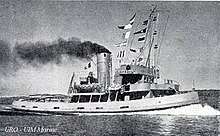
Modified Ocean Warrior-class Tugs built by Kingston Ship Builder in Kingston ON. GT of 233 tons, 105 feet long, Beam of 26.2' and Draft of 12.5' with 1000HP, max of 14 knots, Steel hull, built in 1945 and 1946.[42][43]
- Rockglen
- Rockforest
- Rockpigeon
- Rockdoe
- Rockswift
- Rockelm
- Rockswift
- Rockwing
- Rockcliffe
- Rockmount
- Rockport
- Rockland
- Rockhill
- Rockwood
- Rockruby
- Rockhawk
- Rockthrush
- Rockcrystal
Notable incidents
- Sonoma tug sank off Dio Island in action at San Pedro Bay, Leyte Gulf, Philippines when an enemy bomber crashed into her on 24 October 1944.[44]
- USS Partridge (AM-16) a Minesweeper, converted to a tug, Ocean Tug AT-138, sank after a torpedo from a German E-Boat hit on 11 June 1944. She sank on way to France at 49°30′N 00°50′W, about 11 nmi (13 mi; 20 km) north of Vierville-sur-Mer.[45]
- Matagorda a V4-M-A1 tug, sank in 1946.[46]
- Boon Island a V4-M-A1 tug, sank in 1976.[47]
- Moose Peak a V4-M-A1 tug, sank in 1974. She was a Merchant Marine Ship at Normandy.[48]
- Great Isaac a V4-M-A1 tug, sank in 1947.[49]
- MV 'Mobile Point' a V4-M-A1 tug sank on 23 December 1944 after collided with the SS Beaton Park, a British cargo ship off the coast of Oregon, near the Nestucca Bay National Wildlife Refuge.[50][51]
- YTL-566 sank on the way to Vietnam in the vicinity of Côn Sơn Island, during the Vietnam War.[52]
- YTL-199 sank in 1946.[53]
- Triton (YT-10) fleet tug, sank with all the crew on 30 December 1962 in storm off Huntington, Long Island, New York.[54]
- USS Pokagon (YT-274) sank near Green Cove Springs, Fla. after she capsized on 27 September 1947.[55]
- USS Shahaka (YTB-368) sank after colliding with USS ABSD-2, a floating drydock, midway between the California coast and the Hawaiian Islands at 27° 21'N 136° 29'W in June 1944.[56]
- USS Secota (YTM-415), Sank in collision with submarine, USS Georgia (SSGN-729) on 22 March 1986 near Midway Atoll.[57]
- YT-198 sank after hitting a mine off the Anzio beachhead on 18 February 1944.[58]
- USS Iona (YTB-220) sank after a fire in June 1963.
- ATA-214 Palo Blanco renamed Radnik sank in storm off Syria in 1953.
- ATR-64 renamed La Lumiere sank at mooring in 2008 in Britannia Beach BC.
- AT-171 sank after a collision off the Azores in 1944.Wrecked off Okinawa 9-Oct--45
- USS Mohave (AT-15) ran aground and was wrecked on 13 February 1928 in Massachusetts Bay.
- USS Arapaho (ATF-68) as ARA Comandante General Zapiola in the Argentine Navy ran aground on a reef off Antarctica and sank on 10 January 1976.[59]
- ATF-117 USS Wateree was wrecked and sank off Okinawa on 9 Oct. 1945.
- USS Grebe was wrecked and sank off Fiji on 9 October 1945 with a loss of eight of crew.
- AT-200 Sold and renamed Leucolon (PP 61) was wrecked and sank in 1965.[60]
- ATR-15 was wrecked and sank off Normandy on 19 June 1944.[61]
- AT-31 USS Koka was wrecked and sank in 1938 off San Clemente Island.
- AT-166 Chetco sold and renamed Neptune sank after collision in 1948 [62]
- AT-191 sank by typhoon Louise at Okinawa on 9 Oct. 1945.[63]
- AT-210 USS Catawba renamed ARA Comodoro Somellera (A10)sank in 1998.[64]
See also
- Sotoyomo-class fleet tug
- Victory ships
- Liberty ship
- Type C1 ship
- Type C2 ship
- Type C3 ship
- United States Merchant Marine Academy
- List of auxiliaries of the United States Navy
References
- shipbuildinghistory.com V type ships
- shipbuildinghistory.com, Yard Tugs (YT, YTB, YTM, YTL) Built or Acquired During WWII
- "How Pygmy Tugboats Dock a Giant Liner." Popular Science Monthly, March 1930, p. 22-23.
- Directory of The Ocean Going Tugs type V2-ME-A1, by Hans van der Ster
- navsource, Pogatacut (YT 267)
- navsource, Red Cloud (YT 268)
- navsource, Sakarissa (YT 269)
- www.amphibiousforces.org
- Satanta (YTB-270)
- retiredtugs.org, photo V2-ME-A1, Port Orchard, Santanta (YT 270), Maris Pearl
- navsource YTB 723
- Port Hudson-Wabaquasset (YTB-724)
- shipbuildinghistory.com U.S. Army Ocean Tugs (LT, ST) Built During WWII
- navsource, Nesutan (YT 338)
- navsource, Swatane (YT 344)
- navesource, Oratamin (YT 347)
- navsource, YTM-342
- tugboatinformation.com, LTC Herbert L. Kidwell
- navsource, Haiglar (YT 327)
- navsource, Mauvilla (YT 328)
- www.usmm.org V ships
- The Birth of The General Ship & Engine Works
- usmaritimecommission.de Outboard Profiles of Maritime Commission Vessels The Tug Design's
- Directory of the Ocean Going Tugs type V4-M-A1 by: Hans van der Ster
- Moose Peak
- towingline.com, Directory of The Ocean Going Tugs type V3-S-AH2, (composed by: Hans van der Ster
- towingline.com, Directory of Small Harbor Tugs type V2-M-A L1, composed by: Hans van der Ster]
- NavSource, District Harbor Tug Small (YTL)
- navsource.org, YTL 718
- ATR-7
- navsource.org ATR-1
- ibiblio.org, USS ATR-64
- shipbuildinghistory.com, ATR
- Abnaki
- UN Navy, Pearl Harbor: Why, How, Fleet Salvage and Final Appraisal, by Vice Admiral Homer N. Wallin, page 206
- navsource.org, Sotoyomo
- http://www.navsource.org Cahto (YTB-215)
- "USS Cahto". Dictionary of American Naval Fighting Ships. Navy Department, Naval History and Heritage Command. 2004. Retrieved 30 May 2012.
- Lambert, Bruce (11 January 1992). "James E. Hair, 76, Naval Officer Whose Unit Broke Color Bar, Dies". The New York Times. New York: NYTC. ISSN 0362-4331. Retrieved 30 May 2012.
- USS Bagaduce (AT-21) at the Navy History and Heritage Command

- shipbuildinghistory.com Tug List
- shipbuildinghistory.com, Canada ships of WW2
- A Bridge of Ships: Canadian Shipbuilding During the Second World War, By James Pritchard, page 281
- Directory of Tugs ATO
- usspartridge.com
- tugboatinformation.com Matagorda tug
- Boon Island a V4-M-A1 tug
- shipbuildinghistory.com, General Ship, East Boston MA
- Great Isaac a V4-M-A1
- Mobile Point a V4-M-A1
- Screening Level Risk Assessment Package Mobile Point
- navsource.org, YTL-566
- navsource.org, YTL-199
- navsource.org, Triton (YT-10)
- historycentral.com, USS Pokagon (YT-274)
- navsource, USS Shahaka (YTB-368)
- "Sub sinks a tug boat". YouTube video. Retrieved 17 November 2015.
- .navsource, YT-198
- navsource.org, Arapaho
- navsource, AT-200
- navsource, ATR-15
- Chetco
- US Navy Typhoon Louise
- navsource Catawba